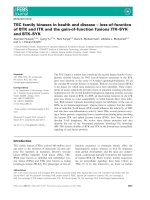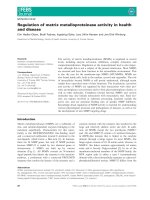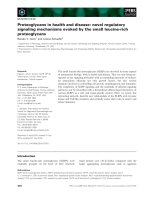Role of miRNA signatures in health and productivity of livestock
Bạn đang xem bản rút gọn của tài liệu. Xem và tải ngay bản đầy đủ của tài liệu tại đây (350.86 KB, 12 trang )
Int.J.Curr.Microbiol.App.Sci (2019) 8(4): 727-738
International Journal of Current Microbiology and Applied Sciences
ISSN: 2319-7706 Volume 8 Number 04 (2019)
Journal homepage:
Review Article
/>
Role of miRNA Signatures in Health and Productivity of Livestock
Aamir Bashir Wara1*, Supriya Chhotaray1, Burhan Ud Din Shafi2, Snehasmita Panda1,
Mitek Tarang1, Saleem Yosuf3, Naseer Ahmad Baba3 and Amit Kumar1
1
3
Division of Animal Genetics, 2Division of Animal Nutrition,
Division of Animal Genetics, ICAR- National Dairy Research Institute,
Karnal, 132001, India
*Corresponding author
ABSTRACT
Keywords
MicroRNA,
Livestock, and
Biomarker
Article Info
Accepted:
07 March 2019
Available Online:
10 April 2019
The knowledge and implementation of microRNA expression profiles in disease diagnosis
and target gene identification have grown exponentially. MicroRNAs as markers of
disease diagnosis and prognosis, and as new therapeutic targets have been substantially
explored in human and animals. Several target gene sites have been identified
experimentally and some are predicted computationally in some livestock and pet species,
and polymorphism at these sites is viewed as a basis for selection. While in the medical
sciences, use of miRNA as a biomarker has gained impetus, the accomplishment in animal
science remains still below adequacy. Below we review the history of its discovery in
various healthy and diseased tissues and body fluids that could pave a way for
improvement of health and productivity in animals.
Introduction
(miRNA), small interfering RNAs (siRNA)
and piwi interacting RNAs (piRNAs).
Eukaryotic gene regulation is known to occur
mostly at the transcriptional level. Recent
research has demonstrated that post
transcriptional
mechanisms
also
play
important role in regulating the expression of
eukaryotic genes. Some of these involve,
base-pairing of small, non-coding RNAs with
target sequences in messenger RNA
molecules, thereby interfering with gene
expression. While some of these non-coding
transcripts are long (long non-coding RNA)
such as Xist, some are short (short non-coding
RNA or sncRNA) such as microRNAs
Micro RNAs are ~21-28 base pairs long,
small non-coding RNAs found associated
with gene expression. More than 60% of
genes undergo direct miRNA regulation and
they regulate gene expression in several
cellular processes such as signal transduction,
cell cycle, differentiation, and transformation
(Friedman et al., 2009). In different livestock
species, miRNAs have been found to have
role in regulating the expression of proteincoding
genes
involving
different
physiological and pathological processes.
727
Int.J.Curr.Microbiol.App.Sci (2019) 8(4): 727-738
miRNA expression profiles in livestock
species are mostly concerned with
productivity, fertility, embryo development,
and disease resistance. miRNAs are also
known to play a role of biomarkers in certain
disease diagnosis. Polymorphisms at miRNA
binding sites of target genes can lead a way
for genetic improvement through associating
it with phenotypes of interest during the
process of genomic selection in livestock
breeding programs (Fatima and Morris,
2013). Till date miRNA expression profiles
have been developed across a variety of
tissues from livestock species. Existence of
miRNAs has also been reported in body fluids
like milk and blood where they exist in
microvesicles or exosomes (Fatima and
Morris, 2013). miRNAs, which play vital role
in biological processes in all cell types across
body, are reported to exhibit ubiquitous
expression (Jin et al., 2009).
expression in mammary gland and milk of
cattle, provides a guide to select desirable
phenotypes
of
economic
importance.
However, a voluminous number of miRNA
studies are conducted on humans as compared
to studies in animals. So, in the present study
we review regarding the techniques of
miRNA detection and application of their
expression profiles in studies of disease
diagnosis, productivity and fertility traits in
various domestic animal species.
miRNA detection methods
Precise miRNA detection in clinical samples
is the key to successful miRNA guided
diagnostics. There are several methods
developed to date for miRNA detection.
These include small RNA sequencing (Hafner
et al., 2012), quantitative real-time PCR
(qRT-PCR) (Chen et al., 2005), miRNA
microarray (Castoldi et al., 2007),
multiplexed miRNA detection with color
coded probe pairs (Geiss et al., 2008), and
miRNA in situ hybridization (Nelson et al.,
2006). Below, we enlist some of the common
approaches reviewed by Gustafson et al.,
(2016) to detect miRNA keeping in view the
diagnostic need. The clinical testing should be
rapid, sensitive, accurate, labour nonintensive, easy to analyse, and cost-effective.
Micro RNAs are synthesized as nascent
longer miRNA transcript, i.e., pri-miRNA in
the nucleus and then processed by the enzyme
Drosha to form Pre-miRNA. Pre-miRNA is
exported to the cytoplasm with the help of
exportin 5 protein, and then cleaved by an
RNAseIII enzyme (Dicer) to form mature
miRNA. RNA induced silencing complex
(RISC) then binds to one of the strands of
mature
miRNA.
The
complementary
sequence of RISC incorporated miRNA base
pairs with target mRNA leading to mRNA
degradation. The overall pathway of miRNA
synthesis is presented in Figure 1.
Small RNA sequencing
Quantitative
detection
along
with
comprehensive profiling is its key features. It
has high sensitivity and specificity but
requires intensive labour and cost.
Aberrant expression of miRNAs affects the
regulation of many cellular functions and
gene networks. The detection of a small
number of miRNAs provides important
information about the course, stage and
prognosis of the disease (Wang et al., 2015).
Tissue and body fluid specific expression of
miRNAs such as expression in skeletal
muscles of sheep, goat and pig while
Quantitative real-time PCR
It is the easiest way of amplification based
detection of miRNA and is comparatively
inexpensive and clinically tractable with high
sensitivity and specificity. It is mostly used to
quantify the levels of a defined set of
miRNAs thus has limited profiling.
728
Int.J.Curr.Microbiol.App.Sci (2019) 8(4): 727-738
A combination of surface poly-(A) enzyme
chemistry and gold nanoparticle-amplified
SPRI measurements is used to detect multiple
miRNAs at attomole levels (Fang et al.,
2006). Is has excellent specificity but
cumbersome analytical procedures are
involved.
miRNA microarray
It is a hybridization based technique that
provides comprehensive profiling and can
simultaneously measure large number of
circulating miRNA. It has low sensitivity and
specificity. It is unable to detect novel
unannotated miRNA and is expensive.
Role of mirna in livestock species
Nano stringn counter expression system
There are several studies that demonstrate a
correlation between expression profiles of
circulating miRNAs and various bacterial
(Paratuberculosis), viral (foot and mouth
disease, bovine virus diarrhoea), parasitic
(Echinococcosis), and metabolic (mastitis)
diseases. Still, in livestock, studies of miRNA
expression profiles are predominantly
concerned with their association with traits of
economic importance, especially traits
associated with milk, meat, and egg
production and traits influencing animal
productivity and fertility. So, below we brief
the role of circulating miRNA in different
species.
It is an emerging technique based on
hybridisation that produces a quantitative
profile of miRNA. It is highly multiplexed,
with high sensitivity and specificity and
provides direct digital detection. High cost
incurring in comparison to other methods.
Northern blotting
It is the most widely used method but has low
sensitivity (de Planell-Saguer and Rodicio,
2011).
Bioluminescence miRNA detection
Solid-phase Protein complementation driven
by DNA hybridization that provides direct
detection of miRNA in total RNA from tissue
and cells. It is a high-throughput miRNA
profiling technique that is highly sensitive and
rapid (Cissell et al., 2008).
Cattle
One of the most economically important
disease that causes a huge loss is Foot-andmouth disease. Stenfeldt et al., (2017)
observed that, miR-1281 was significantly
reduced at both acute and persistent infection
stages while bta-miR-17-5p was expressed in
the highest level at acute infection stage.
Surface enhanced Raman spectroscopy
(SERS)
It involves the mechanism of absorption of
miRNA to silver or gold nano-rods for labelfree miRNA detection. It has excellent
reproducibility
and
single
nucleotide
specificity but requires high analytical skill
(Driskell et al., 2008).
They also reported that bta-miR-31 level was
significantly increased during persistence
stage. Gutkoska et al., (2017) reported the
role of host miR-203a in FMDV replication in
host, where miR-203a-3p and miR-203a-5p
showed anti-viral activity for FMDV by
regulating Sam68 and Survivin expression in
host. Basagoudanavar et al., (2018) reported
72 up-regulation of 72 on 2 DPI, among
which, 39 miRNAs were statistically
differentially upregulated. They also reported
Surface plasmon resonance imaging (SPRI)
Is a label-free detection method that can
monitor molecular interactions on a surface.
729
Int.J.Curr.Microbiol.App.Sci (2019) 8(4): 727-738
two fold change in expression of bta-miR-215p, bta-miR-101, bta-miR-126-3p, bta-miR145, bta-miR-197 and bta-miR-223 in serum
samples in 2 DPI.
now the two most common causes of bovine
mastitis.
Ogorevc et al., (2009) reported 359 putative
target sites for miRNAs on a set of candidate
gene and genetic markers for mastitis and
milk production in mammary gland. They
suggested the role of miR-31during early
lactation period which is increased compared
with the dry period. It was also reported by
them that DQA2-SV1 as well as miR-296,
miR-2430, and miR-671 had a higher
expression, while miR-2318 had a lower
expression in tissue affected by mastitis. The
expression of specific miRNAs in response to
bacterial infection can be examined by in vivo
challenge of bacterial pathogens into
mammary tissues of the cows, for example,
Streptococcus uberis (Lawless et al., 2013;
Lawless et al., 2014; Naeem et al., 2012),
Staphylococcus aureus (Jin et al., 2014) and
Escherichia coli (Dilda et al., 2012; Jin et al.,
2014). In Streptococcus uberis infection of
mammary tissue it was observed that, miR181, miR-16, and miR-31 had a lower
expression in infected tissues, while miR-223
had an increased expression (Naeem et al.,
2012). miR-31 and miR-223 were found to be
involved in inhibition of lipid metabolism,
whereas miR-181a plays major roles in
phagocytosis and antigen processing and
presentation in infected mammary tissue
(Naeem et al., 2012).
Taxis et al., (2017) investigated miRNA
profiles of Bovine viral diarrhoea virus
(BVDV) infected colostrum deprived male
Holstein calves. They observed differential
expression of two circulating miRNAs (BtamiR-423-5p and Bta-miR-151-3p) in acute
stage of fever and lymphopenia. However,
only Bta-miR-151-3p expression was
significantly up-regulated at 9 days postinfection compared to the control group.
Thus, Dong et al., (2017) suggested that these
two miRNAs based on the above findings
may not serve as appropriate diagnostic
biomarkers.
Johne’s
disease
also
known
as
Paratuberculosis is a chronic disease caused
by
Mycobacterium
paratuberculosis.
Shaughnessy et al., (2017) reported that there
is no significant differential expression of
circulating miRNA in Paratuberculosis
infection. Recently, Malvisi et al., (2016)
found significant down-regulation of bta-mir19b, bta-mir-19b-2, bta-mir-1271, bta-mir100, bta-mir-301a, bta-mir-32, and one Novel
miRNA, while bta-mir-6517 and bta-mir7857 levels were increased in positive
animals.
Mastitis and mammary tissue infections
Staphylococcus aureus is another important
pathogen causing mastitis in cattle, leading to
substantial milk, quality, and economic loss to
dairy farmers worldwide. Sun et al., (2015)
reported up-regulation in miRNA expression
profiles of bta-miR-142-5p and bta-miR-223,
during mid-lactation prior to and after
infection (48 h) in Holstein cows. The
inflammatory processes in mammary glands
stimulated by E. coli LPS and S. aureus
enterotoxin B (SEB)in bovine monocytes
(CD14+ cells) may possibly be associated
Bovine mastitis, defined as ‘inflammation of
the mammary gland’, can have an infectious
or non-infectious aetiology. Organisms as
diverse as bacteria, mycoplasma, yeasts and
algae have been implicated as causes of the
disease. Watts (1988) identified 137 different
organisms as a cause of mastitis. Mastitis
remains a major challenge to the worldwide
dairy industry despite the widespread
implementation of mastitis control strategies.
Escherichia coli and Streptococcus uberis are
730
Int.J.Curr.Microbiol.App.Sci (2019) 8(4): 727-738
with miR-9, miR-125b, miR-155, miR-146a
and miR-223 (Dilda et al., 2012). In
particular, bta-miR-142-5p, and miR-223 are
potential biomarkers for early detection of
bacterial infection of the mammary gland.
infected PBMC and PPRV infected PBMC.
They found a total of 316 miRNA (103
known and 213 novel miRNA) those were
differentially expressed in the two groups.
They also found chi-miR-204-3p and one
novel miRNA that were up-regulated whereas
chi-miR-338-3p, chi-miR-30b-3p, chi-miR199a-5p, chi-miR-199a-3p, chi-miR-1, and
two novel miRNAs are down-regulated in
mock-infected goat PBMC compared with the
PPRV-infected cells. Pandey et al., (2017)
identified a total of 67 and 37 DEmiRNAs in
lungs and 50 and 56 DEmiRNAs in spleen of
PPR infected goats and sheep, respectively.
They also suggested a total of 20 and 11
miRNAs are common in expression in both
sheep and goat PPRV infected spleen and
lung, respectively.
Many researchers have also emphasized the
role of miRNA in bovine fertility. In one
study maturation of oocytes at different stages
were studied and seven miRNAs (miR-496,
miR-297, miR-292-3p, miR-99a, miR-410,
miR-145, and miR-515-5p) were reported to
be more abundant in mature oocytes, while
two miRNAs (miR-512-5p and miR-214)
were more abundant in immatures (Tesfaye et
al., 2009). In another study, seven miRNAs
were reported to be differentially expressed in
the spermatozoa of high- and low-fertile
Holstein bulls (Govindaraju et al., 2012).
In small ruminants like sheep and goat the
muscle traits are of chief economic
importance. One of the gene regulating
skeletal muscle growth is myostatin and SNPs
at binding sites formiR-1 and miR-26 on the
myostatin locus have been linked with
muscular hypertrophy in sheep (Clop et al.,
2006). The Callipygian (CLPG) phenotype is
a paternally inherited muscular hypertrophy in
Texel sheep and Caiment et al., (2010)
reported the expression of some miRNAs
those were associated with CLPG phenotype.
In a comparative study between Ujumqin and
Texel lamb longissimus muscle, miR-1 and
miR-214 were reported to be overexpressed in
Ujumqin lambs (Zhang et al., 2013).
miRNAs also play an important role in
pregnancy diagnosis and can serve as the
most potent biomarker for early pregnancy
detection. Ioannidis and Donadeu (2017)
confirmed significant differences in the
expression of let-7f, let-7c, miR-30c, miR101, miR-26a, miR-205 and miR-143
between 0-60th days of pregnancy. Significant
up-regulation of circulatory levels of miR-26a
as early as 8th (Ioannidis and Donadeu, 2017)
and 30th day (Markkandan et al., 2018) of
conception has been observed. Some miRNAs
(miR-92a and miR-486) were found to be
highly
expressed
post-pregnancy
(Markkandan et al., 2018).
In the mammary gland of Prealpes-duSudewes’miR-21 and miR-205were expressed
in early and mid-pregnancy with miR-21
being more highly expressed in epithelial
cells in early pregnancy and miR-205 more
highly expressed during late pregnancy (Galio
et al., 2013). In addition, they also reported
the increased expression of miR-200a, miR200b, miR-200c, miR-141, and miR-429 in
late pregnancy and lactation.
Sheep and goat
The most common disease affecting small
ruminants is Peste des Petits Ruminants
(PPR) that causes a great economic loss. Qi et
al., (2018) in an experiment, infected
peripheral blood mononuclear cells (PBMC)
of goats with Nigeria 75/1 vaccine virus (a
common vaccine used for PPRV) and studied
the expression profiles of miRNA in mock
731
Int.J.Curr.Microbiol.App.Sci (2019) 8(4): 727-738
Li et al., (2011) have identified a total of 346
conserved and 95 novel miRNAs in dairy
goats’ mammary gland at peak lactation and
dry period. In another study of Laoshan Dairy
goats, miRNAs expression profile showed upregulation of miR-17a and down-regulation of
miR-883 in late lactation in the mammary
tissue (Ji et al., 2012).In both the periods,
miR-143,miR-143-3p, miR-148a-3p, let-7-5p,
and let-7b were co-expressed.
White pigs, whereas miR-1a, miR-133a, miR122, miR-204, and miR-183 in Meishan pigs.
Expression of miRNA varies from breed to
breed and also differentially expressed in
tissues for example the miRNA expressed in
adipose tissues may not be expressed in
skeletal tissues. Li et al., (2012), in a study
reported increased expression of miR-296 in
adipose compared with muscle tissues in the
Landrace breed, whereas, the Lantang breed
showed higher expression of miR-17 in
adipose compared with longissimus muscle.
They also reported higher expression of miR143in adipose tissue than in muscle tissue in
both the breeds.
Pig
The porcine whipworm infestation that occurs
due to Trichuris suis, is epidemic all over the
world, leads to reduced feed efficiency,
reduced
growth
rates,
haemorrhagic
diarrhoea, and death (Roepstorff et al., 2011).
Hansen et al., (2016) found significant upregulation in levels of circulating miRNA,
ssc-let-7d-3p, at 8 weeks post infection. But
this miRNA may not be a suitable biomarker
as the pre-patent period of T. suis is 6–7
weeks.
The genetically modified pigs serve as the
most suitable source of organ for
xenotransplantation in humans due to longer
survival and less rejection (Cooper et al.,
2016). To diagnose the cases of acute
rejection (AR), disease recurrence, and drug
toxicity
after
xenotransplantation
the
recommended practice is biopsy. Shan et al.,
(2011), stated the possible role of miRNA in
detecting allograft function or acute rejection.
Levels of miR-142-5p, miR-155 and miR-223
individually can predict acute rejection with
>90% sensitivity and specificity in human
renal allografts (Tao et al., 2015).
In pigs meat quality traits are of much
importance due to upsurge in pork
consumption. In porcine skeletal muscle miR1 was found to be moderately expressed in
developmental stages while highly expressed
in adult tissue (McDaneld et al., 2009). In a
study by Nielsen et al., (2010), miR-1and
miR-206 were found to be highly expressed in
porcine skeletal muscle. In one study, Holley
et al., (2011) found polymorphisms inmiR-1
from three breeds of pig that affect muscle
fibre formation, while Cho et al., (2010)
reported that miR-1 andmiR-133 were more
highly expressed in porcine skeletal muscle
compared with adipose tissues. The fat
content of meat important to maintain its
texture, flavour and quality. In a comparative
study of miRNA expression between back fat
of Large White (lean type) and Meishan
(Chinese indigenous) pigs, Chen et al., (2012)
observed increased expression of miR-215,
miR-135, miR-224, and miR-146b in Large
Role of mirna in pet animals
Canines and felines
Canines
are
most
susceptible
to
cardiovascular diseases and there are ample of
researches regarding role of miRNA in these
diseases in different breeds of dogs. miRNA
play an important role in the development of
heart failure and cardiac remodelling
(Condorelli et al., 2014). Changes in the
expression of miR-1, miR- 21, miR-23, miR133, miR-199, miR-208 and miR-320 in
Congestive heart failure (CHF) has been
reported by Topkara and Mann (2011). It also
plays an important role in mitral valve disease
732
Int.J.Curr.Microbiol.App.Sci (2019) 8(4): 727-738
in dogs. Li et al., (2012) reported underexpression of microRNAs; cfa-miR-487b and
cfa-miR-582 and overexpression of cfa-miR103, cfa-miR-98, cfa-let-7c and cfa-let-7b in
symptomatic
mitral
valve
disease.
Hulanickaet al., (2014) studied miRNA
expression in Dachshunds in various phases
of MVD. They reported down-regulation of
miR-30b in dogs with class B and C disease
when compared to those with class A, while
the microRNAs miR-133b, miR-125, miR126, miR-21, miR-29b and miR-30b were
down-regulated in dogs with class C disease.
They suggested the role of miR-133b as a
potential biomarker for stage C congestive
heart failure. A common type of arrhythmia in
dogs is Atrial Fibrillation (AF). Zhang et al.,
(2015) reported over-expression of micro-cfamiR-206 in dogs with AF. They also reported
dysregulated expression of 16 other
microRNAs in dogs with AF. Li et al., (2012)
showed down-regulation of miR-133 and
miR-30 in dogs with atrial fibrillation.
Feline cardiomyopathy
The most common type of feline cardio
myopathy is Hypertrophic cardiomyopathy
(HCM) that is known to have a strong genetic
predisposing factor. According to Weber et
al., (2015), 49 microRNAs are related to
cardiac hypertrophy in cats. miR-381-3p,
miR-486-3p, miR5700, miR-513a-3p and
miR-320E has already been recognized to be
up-regulated in cats with stable congestive
heart failure secondary to HCM.
Other than cardiovascular diseases, a recent
study by Dirksen et al., (2016) reported the
role of miR-122, as a biomarker to measure
hepatocyte damage in Labrador Retriever
dogs. Fujiwara-Igarashi et al., (2015) assessed
277 microRNAs out of which let-7b, miR223, miR-25 and miR-92a showed decreased
expression while miR-423A showed overexpression in dogs with lymphoma compared
with the control group.
Fig.1 miRNA biogenesis and function in gene expression regulation
733
Int.J.Curr.Microbiol.App.Sci (2019) 8(4): 727-738
Parvo-viral infection
References
Feline parvovirus (FPV) and canine
parvovirus (CPV) variants are one of the most
common pathogens of feline and canine
species. Zhou et al., (2017) reported
differential expression of miRNA in cats and
dogs infected with FPV and CPV. 156
miRNAs showed up-regulation and 87
showed down-regulation in the FPV infection
group, while 91 were up-regulated and 31
were downregulated in the CPV infection
group. In common, 10 were up-regulated and
26 down-regulated in both the FPV and CPV
infection groups.
Basagoudanavar, S H, Hosamani M, Selvan R
T, Sreenivasa B P, Sanyal A and
Venkataramanan R. 2018. Host serum
microRNA profiling during the early
stage of foot-and-mouth disease virus
infection. Archives of Virology 3:1-9.
Caiment, F, Charlier C, Hadfield T, Cockett
N, Georges M and Baurain D. 2010.
Assessing the effect of the CLPG
mutation on the microRNA catalog of
skeletal muscle using high-throughput
sequencing. Genome Research 13.
Castoldi, M, Benes V, Hentze M W and
Muckenthaler M U. 2007. miChip: a
microarray platform for expression
profiling of microRNAs based on
locked
nucleic
acid
(LNA)
oligonucleotide
capture
probes.
Methods 43(2):146-52.
Chen, C, Deng B, Qiao M, Zheng R, Chai J,
Ding Y, Peng J and Jiang S. 2012.
Solexa sequencing identification of
conserved and novel microRNAs in
backfat of Large White and Chinese
Meishan pigs. PloS One 7(2):31426.
Chen, C, Ridzon D A, Broomer A J, Zhou Z,
Lee D H, Nguyen J T, Barbisin M, Xu
N L, Mahuvakar V R, Andersen M R
and Lao K Q. 2005. Real-time
quantification of microRNAs by
stem–loop RT–PCR. Nucleic Acids
Research 33(20):179.
Cho, I S, Kim J, Seo H Y, Lim D H, Hong J
S, Park Y H, Park D C, Hong K C,
Whang K Y and Lee Y S. 2010.
Cloning and characterization of
microRNAs from porcine skeletal
muscle and adipose tissue. Molecular
Biology Reports 37(7):3567-74.
Cissell, K A, Rahimi Y, Shrestha S, Hunt E A
and Deo S K. 2008. Bioluminescencebased detection of microRNA, miR21
in breast cancer cells. Anal Chem
80(7):2319-25.
In conclusion we have highlighted the role of
miRNAs in regulation of important economic
traits and diseases in livestock animals in this
review. Several studies have shown that
miRNAs are differentially expressed in
different tissues and body fluids potentially
making them useful for associating them with
various traits. Many researchers have studied
miRNA signatures that are representative of
diseases, including cancer, viral and bacterial
infections, and fertility disorders.
Differential expression of miRNAs in
diseased tissue makes it an important
biomarker for disease diagnosis in various
domestic animals. The breed-dependent
variation in expression of miRNAs and
polymorphism in miRNA target sites on
important genes related with animal
productivity could be implemented as a basis
in selection programs in livestock species.
Acknowledgement
This study was supported by the ICAR-Indian
Veterinary Research Institute, Government of
India. The authors would also wish to
acknowledge the Director and Joint Director
Academic and Research, IVRI, Bareilly,
India, for their kind support to carry out this
review.
734
Int.J.Curr.Microbiol.App.Sci (2019) 8(4): 727-738
Clop, A, Marcq F, Takeda H, Pirottin D,
Tordoir X, Bibé B, Bouix J, Caiment
F, Elsen JM, Eychenne F and Larzul
C. 2006. A mutation creating a
potential illegitimate microRNA target
site in the myostatin gene affects
muscularity in sheep. Nature Genetics
38(7):813.
Condorelli G, Latronico M V and Cavarretta
E. 2014. microRNAs in cardiovascular
diseases: current knowledge and the
road ahead. Journal of the American
College of Cardiology 63(21):217787.
Cooper, D K, Ezzelarab M B, Hara H, Iwase
H, Lee W, Wijkstrom M and Bottino
R. 2016. The pathobiology of
pig‐to‐primate xenotransplantation: a
historical review. Xenotransplantation
23(2):83-105.
dePlanell-Saguer M and Rodicio M C. 2011.
Analytical aspects of microRNA in
diagnostics: a review. Analytica
chimica acta 699(2):134-52.
Dilda, F, Gioia G, Pisani L, Restelli L, Lecchi
C, Albonico F, Bronzo V, Mortarino
M and Ceciliani F. 2012. Escherichia
coli
lipopolysaccharides
and
Staphylococcus aureus enterotoxin B
differentially modulate inflammatory
microRNAs in bovine monocytes. The
Veterinary Journal 192(3):514-6.
Dirksen K, Verzijl T, van den Ingh T S,
Vernooij J C, van der Laan L J,
Burgener I A, Spee B and Fieten H.
2016. Hepatocyte-derived microRNAs
as sensitive serum biomarkers of
hepatocellular injury in Labrador
retrievers. The Veterinary Journal
211:75-81.
Dong, H, Gao Q, Peng X, Sun Y, Han T,
Zhao B, Liu Y, Wang C, Song X, Wu
J and Yang L. 2017. Circulating
MicroRNAs as potential biomarkers
for veterinary infectious diseases.
Frontiers in veterinary science 4:186.
Driskell J D, Seto A G, Jones L P, Jokela S,
Dluhy R A, Zhao Y P and Tripp R A.
2008. Rapid microRNA (miRNA)
detection and classification via
surface-enhanced Raman spectroscopy
(SERS).
Biosensors
and
Bioelectronics 24(4):917-22.
Fang, S, Lee H J, Wark A W and Corn R M.
2006. Attomole microarray detection
of microRNAs by nanoparticleamplified SPR imaging measurements
of surface polyadenylation reactions.
Journal of the American Chemical
Society 128(43):14044-6.
Fatima A and Morris DG. 2013. MicroRNAs
in domestic livestock. Physiological
Genomics 45(16):685-96.
Friedman R C, Farh K K, Burge C B and
Bartel D P. 2009. Most mammalian
mRNAs are conserved targets of
microRNAs.
Genome
Research
19(1):92-105.
Fujiwara-Igarashi, A, Igarashi H, Mizutani N,
Goto-Koshino Y, Takahashi M, Ohno
K and Tsujimoto H. 2015. Expression
profile
of
circulating
serum
microRNAs in dogs with lymphoma.
The Veterinary Journal 205(2):31721.
Galio, L, Droineau S, Yeboah P, Boudiaf H,
Bouet S, Truchet S and Devinoy E.
2012. MicroRNA in the ovine
mammary
gland
during
early
pregnancy: spatial and temporal
expression of miR-21, miR-205, and
miR-200. Physiological Genomics
45(4):151-61.
Geiss, G K, Bumgarner R E, Birditt B, Dahl
T, Dowidar N, Dunaway D L, Fell H
P, Ferree S, George R D, Grogan T
and James J J. 2008. Direct
multiplexed measurement of gene
expression with color-coded probe
pairs.
Nature
Biotechnology
26(3):317.
Govindaraju, A, Uzun A, Robertson L, Atli M
735
Int.J.Curr.Microbiol.App.Sci (2019) 8(4): 727-738
O, Kaya A, Topper E, Crate E A,
Padbury J, Perkins A and Memili E.
2012. Dynamics of microRNAs in bull
spermatozoa. Reproductive Biology
and Endocrinology 10(1):82.
Gustafson, D, Tyryshkin K and Renwick N.
2016. microRNA-guided diagnostics
in clinical samples. Best practice &
research Clinical endocrinology &
metabolism 30(5):563-75.
Gutkoska, J, LaRocco M, Ramirez-Medina E,
De Los Santos T and Lawrence P.
2017. Host microRNA-203a is
antagonistic to the progression of footand-mouth disease virus infection.
Virology. 504:52-62.
Hafner, M, Renwick N, Farazi T A,
Mihailović A, Pena J T and Tuschl T.
2012. Barcoded cDNA library
preparation for small RNA profiling
by
next-generation
sequencing.
Methods 58(2):164-70.
Hansen, E P, Kringel H, Thamsborg S M, Jex
A and Nejsum P. 2016. Profiling
circulating miRNAs in serum from
pigs infected with the porcine
whipworm, Trichuris suis. Veterinary
parasitology 223:30-3.
Holley, C L and Topkara V K. 2011. An
introduction to small non-coding
RNAs: miRNA and snoRNA.
Cardiovascular drugs and therapy
25(2):151.
Hulanicka, M, Garncarz M, ParzenieckaJaworska M and Jank M. 2014.
Plasma
miRNAs
as
potential
biomarkers of chronic degenerative
valvular disease in Dachshunds. BMC
Veterinary Research 10(1):205.
Ioannidis, J and Donadeu F X. 2017. Changes
in circulating microRNA levels can be
identified as early as day 8 of
pregnancy in cattle. PloS one
12(4):0174892.
Ji Z, Wang G, Xie Z, Wang J, Zhang C, Dong
F and Chen C. 2012. Identification of
novel and differentially expressed
microRNAs of dairy goat mammary
gland tissues using Solexa sequencing
and bioinformatics.
PloS one.
7(11):49463.
Jin W, Ibeagha-Awemu E M, Liang G,
Beaudoin F and Zhao X. 2014.
Transcriptome microRNA profiling of
bovine mammary epithelial cells
challenged with Escherichia coli or
Staphylococcus
aureus
bacteria
reveals pathogen directed microRNA
expression profiles. BMC genomics
15(1):181.
Lawless, N, Foroushani A B, McCabe M S,
O’Farrelly C and Lynn D J. 2013.
Next generation sequencing reveals
the expression of a unique miRNA
profile in response to a gram-positive
bacterial
infection.
PloS
one.
8(3):57543.
Lawless N, Reinhardt T A, Bryan K, Baker
M, Pesch B, Zimmerman D, Zuelke K,
Sonstegard T, O'farrelly C, Lippolis J
D and Lynn D J. 2014. MicroRNA
regulation of bovine monocyte
inflammatory and metabolic networks
in an in vivo infection model. G3:
Genes, Genomes, Genetics g3-113.
Li G, Li Y, Li X, Ning X, Li M and Yang G.
2011. MicroRNA identity and
abundance in developing swine
adipose tissue as determined by
Solexa sequencing. Journal of cellular
biochemistry 112(5):1318-28.
Li, H, Li S, Yu B and Liu S. 2012. Expression
of miR-133 and miR-30 in chronic
atrial fibrillation in canines. Molecular
Medicine Reports 5(6):1457-60.
Li, Z, Lan X, Guo W, Sun J, Huang Y, Wang
J, Huang T, Lei C, Fang X and Chen
H. 2012. Comparative transcriptome
profiling of dairy goat microRNAs
from dry period and peak lactation
mammary gland tissues. PloS One
7(12):52388.
736
Int.J.Curr.Microbiol.App.Sci (2019) 8(4): 727-738
Malvisi, M, Palazzo F, Morandi N, Lazzari B,
Williams J L, Pagnacco G and
Minozzi G. 2016. Responses of bovine
innate immunity to Mycobacterium
avium
subsp.
paratuberculosis
infection revealed by changes in gene
expression and levels of microRNA.
PLoS One 11(10):0164461.
Markkandan K, Ahn K, Lee D J, Kim T I,
Dang C, Hong S E, Yoon H B, Lim H
J and Hong C P. Profiling and
identification of pregnancy-associated
circulating microRNAs in dairy cattle.
Genes & Genomics 1-7.
McDaneld, T G, Smith T P, Doumit M E,
Miles J R, Coutinho L L, Sonstegard T
S, Matukumalli L K, Nonneman D J
and Wiedmann R T. 2009. MicroRNA
transcriptome profiles during swine
skeletal muscle development. BMC
genomics 10(1):77.
Naeem A, Zhong K, Moisá S J, Drackley J K,
Moyes K M and Loor J J. 2012.
Bioinformatics analysis of microRNA
and putative target genes in bovine
mammary tissue infected with
Streptococcus uberis1. Journal of
dairy science 95(11):6397-408.
Nelson, P T, Baldwin D A, Kloosterman W P,
Kauppinen S, Plasterk R H and
Mourelatos Z. 2006. RAKE and LNAISH reveal microRNA expression and
localization in archival human brain.
RNA 12(2):187-91.
Nielsen M, Hansen J H, Hedegaard J, Nielsen
R O, Panitz F, Bendixen C and
Thomsen B. 2010. MicroRNA identity
and abundance in porcine skeletal
muscles
determined
by
deep
sequencing.
Animal
Genetics
41(2):159-68.
Ogorevc, J, Kunej T, Razpet A and Dovc P.
2009. Database of cattle candidate
genes and genetic markers for milk
production and mastitis. Animal
Genetics 40(6):832-51.
Pandey, A, Sahu A R, Wani S A, Saxena S,
Kanchan S, Sah V, Rajak K K,
Khanduri A, Sahoo A P, Tiwari A K
and Mishra B. 2017. Modulation of
Host miRNAs Transcriptome in Lung
and Spleen of Peste des Petits
Ruminants Virus Infected Sheep and
Goats. Frontiers in microbiology
8:1146.
Qi X, Wang T, Xue Q, Li Z, Yang B and
Wang J. 2018. MicroRNA expression
profiling of goat peripheral blood
mononuclear cells in response to peste
des petits ruminants virus infection.
Veterinary Research 49(1):62.
Roepstorff, A, Mejer H, Nejsum P and
Thamsborg S M. 2011. Helminth
parasites in pigs: new challenges in
pig production and current research
highlights. Veterinary Parasitology
180(1-2):72-81.
Shan J, Feng L, Luo L, Wu W, Li C, Li S and
Li Y. 2011. MicroRNAs: potential
biomarker in organ transplantation.
Transplantation
Immunology
24(4):210-5.
Shaughnessy, R G, Farrell D, Riepema K,
Bakker D and Gordon S V. 2015.
Analysis of bio banked serum from a
Mycobacterium
avium
subsp
paratuberculosis bovine infection
model confirms the remarkable
stability of circulating miRNA profiles
and defines a bovine serum miRNA
repertoire. PLoS One 10(12):145089.
Stenfeldt, C, Arzt J, Smoliga G, LaRocco M,
Gutkoska J and Lawrence P. 2017.
Proof-of-concept study: profile of
circulating microRNAs in Bovine
serum harvested during acute and
persistent FMDV infection. Virology
journal 14(1):71.
Sun, J, Aswath K, Schroeder S G, Lippolis J
D, Reinhardt T A and Sonstegard T S.
2015. MicroRNA expression profiles
of bovine milk exosomes in response
737
Int.J.Curr.Microbiol.App.Sci (2019) 8(4): 727-738
to Staphylococcus aureus infection.
BMC genomics 16(1):806.
Tao, J, Yang X, Han Z, Lu P, Wang J, Liu X,
Wu B, Wang Z, Huang Z, Lu Q and
Tan R. 2015. Serum MicroRNA-99a
helps detect acute rejection in renal
transplantation. Transplant Proc.
Elsevier 47(6):1683-1687.
Taxis T M, Bauermann F V, Ridpath J F and
Casas
E.
2017.
Circulating
microRNAs in serum from cattle
challenged with bovine viral diarrhea
virus. Frontiers in genetics 8:91.
Tesfaye, D, Worku D, Rings F, Phatsara C,
Tholen E, Schellander K and Hoelker
M. 2009. Identification and expression
profiling of microRNAs during bovine
oocyte maturation using heterologous
approach. Molecular reproduction and
development 76(7):665-77.
Topkara, V K and Mann D L. 2011. Role of
microRNAs in cardiac remodeling and
heart failure. Cardiovascular drugs
and therapy 25(2):171-82.
Wang, J, Chen J and Sen S. 2016. MicroRNA
as biomarkers and diagnostics.
Journal of cellular physiology
231(1):25-30.
Watts, J L. 1988. Etiological agents of bovine
mastitis. Veterinary Microbiology
16(1):41-66.
Weber, K, Rostert N, Bauersachs S and Wess
G. 2015. Serum microRNA profiles in
cats
with
hypertrophic
cardiomyopathy.
Molecular
and
Cellular Biochemistry 402(1-2):17180.
Zhang S, Zhao F, Wei C, Sheng X, Ren H, Xu
L, Lu J, Liu J, Zhang L and Du L.
2013.
Identification
and
characterization of the miRNA
transcriptome of Ovis aries. PLoS One
8(3):58905.
Zhang, Y, Zheng S, Geng Y, Xue J, Wang Z,
Xie X, Wang J, Zhang S and Hou Y.
2015. MicroRNA profiling of atrial
fibrillation in canines: miR-206
modulates intrinsic cardiac autonomic
nerve remodeling by regulating SOD1.
PloS one 10(3):122674.
Zhou, P, Zhang X, Zeng W, Zheng Q, Hao X,
Lin X, Zheng Y, Wang L, Zhang G
and Li S. 2017. MicroRNA expression
analysis of feline and canine
parvovirus infection in vivo (felis).
PloS one 12(10):185698.
How to cite this article:
Aamir Bashir Wara, Supriya Chhotaray, Burhan Ud Din Shafi, Snehasmita Panda, Mitek
Tarang, and Amit Kumar. 2019. Role of miRNA Signatures in Health and Productivity of
Livestock. Int.J.Curr.Microbiol.App.Sci. 8(04): 727-738.
doi: />
738









